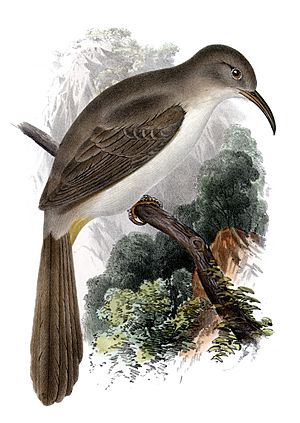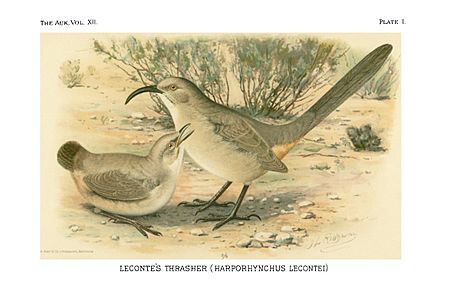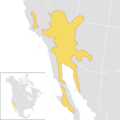LeConte's thrasher facts for kids
Quick facts for kids LeConte's thrasher |
|
|---|---|
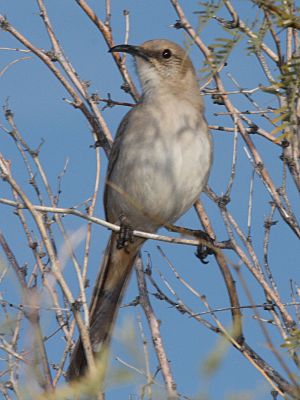 |
|
| Conservation status | |
| Scientific classification | |
| Genus: |
Toxostoma
|
| Species: |
lecontei
|
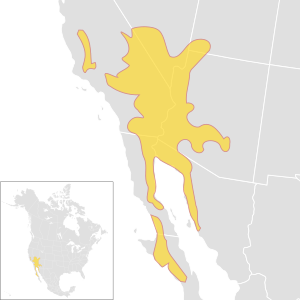 |
|
| LeConte's thrasher range | |
The LeConte's thrasher (Toxostoma lecontei) is a light-colored bird. You can find it in the southwestern United States and northwestern Mexico. These birds love living in deserts where there aren't many plants. Their pale feathers help them blend in with the sandy ground.
LeConte's thrashers don't migrate, which means they stay in the same area all year long. Even though their numbers have gone down in some places, especially in California, there are still enough of them that they are not considered an endangered species. These birds mostly stay on the ground and only fly when they need to. Both male and female thrashers help build the nest, keep the eggs warm, and care for their young.
Contents
About the LeConte's Thrasher Name
The LeConte's thrasher is named after Dr. John Lawrence LeConte. He was an entomologist, which is a scientist who studies insects. Dr. LeConte later became the president of a big science group called the American Association for the Advancement of Science.
There are two main types, or subspecies, of the LeConte's thrasher:
- T.l. lecontei (Lawrence, 1851): This type lives in the southwestern United States. This includes parts of California, Utah, and Arizona. It also lives in northwestern Mexico, in Baja California and Sonora.
- T.l. arenicola (Anthony, 1897): This type is also called the Rosalia thrasher. It lives along the west coast of Baja California.
Scientists have discussed if T.l. arenicola should be its own separate species. However, many still consider it a subspecies of the LeConte's thrasher.
The LeConte's thrasher is closely related to the California thrasher and the crissal thrasher. These three birds are similar because they have a curved beak, long legs, and small wings. These features help them run and dig for food.
What the LeConte's Thrasher Looks Like
LeConte's thrashers weigh about 55 to 75 g (1.9 to 2.6 oz). They are about 24.5–29 cm (9.6–11.4 in) long. Male and female thrashers look very similar. Their wings are short and rounded, which is common for birds that don't fly much.
The main type, T.c. lecontei, has a sandy pale-gray color on its head, back, and shoulders. Its wing feathers are grayish-brown. The tail feathers are a darker gray-brown, which stands out from the rest of its body. The area around its eyes and ears is a mottled gray-brown. Its throat is off-white with a darker stripe. The chest and belly are puffy gray, and the area under its tail is a warmer color. Its eyes are brown, its curved beak is black, and its legs are almost black.
The other type, T.l. arenicola, has a darker chest and belly. It also has a shorter tail. Young thrashers are darker brown. Their feathers look looser and fluffier, especially under their tail.
Where LeConte's Thrashers Live
These birds live in some of the toughest climates. This includes the Sonoran Desert and the San Joaquin Valley. In these areas, it only rains about 4 to 20 centimeters (1.5 to 8 inches) each year.
They prefer desert habitats with sand dunes, flat areas, and gentle hills. They like places with small dry riverbeds and not many plants. The plants they do use include low bushes like saltbush, creosote, cholla cacti, and Mojave yucca. They can live from 80 meters (260 feet) below sea level in Death Valley to as high as 1,600 meters (5,250 feet). However, they usually live around 500 meters (1,640 feet) above sea level.
In some areas, like the Coachella Valley, Imperial Valley, and San Joaquin Valley, the number of LeConte's thrashers has decreased. This is mainly because of cities growing, land being used for farms and oil, and fires. Even though their numbers are small for a bird, they live across a large area. Because of this, they are not considered a species at risk.
LeConte's Thrasher Behavior
This thrasher spends most of its time on the ground. It only flies when it's building a nest or feeding its young. It can run surprisingly fast, even faster than a trotting horse! When it runs, it usually holds its tail up high.
LeConte's thrashers find their food on the ground. They dig small holes in leaves or soil to find their prey. These birds usually stay with one partner and are often seen in pairs. Young thrashers sometimes form small groups of two to eight birds.
Their Song and Calls
The LeConte's thrasher has a long, flowing song. It sounds like a mix of warbled phrases that can be repeated many times. You can hear their song from far away. The song starts softly, then gets louder. It is often sung from a high spot, usually in the morning or evening. Sometimes, they even sing at night. Female thrashers also sing sometimes.
Their calls include a short whistle note like suuuweeee or hew-eep. They also have a double-noted whistling call when they are in distress.
What They Eat
LeConte's thrashers eat both plants and animals. Their diet includes arthropods like beetles, scorpions, spiders, grasshoppers, and moth larvae. They also eat small lizards and snakes. Sometimes, they even eat eggs, including eggs from their own species. For plants, they eat seeds and berries.
These birds are good at saving water, which helps them live in the desert. They usually get all the water they need from their food. They rarely need to drink water.
LeConte's Thrasher Reproduction
The singing season for LeConte's thrashers starts in the middle of autumn. It is loudest in late December and early January. This is when they start building their nests.
Their nests are usually big and bulky. The outside layer is made of twigs. The middle layer has twigs, grasses, and small roots. The inside layer is soft, made of fuzzy plant seeds, leaves, or flowers. They like to build nests in thick, thorny bushes like saltbush. Nests are usually about half a meter (1.5 feet) off the ground. Both male and female thrashers help build the nest, though the male's help can vary.
In California, eggs are usually laid from February to May. In the Sonoran region, it's from December to April. They usually lay 2 to 5 eggs, but most often 3 or 4. The eggs are large and bluish-green. They might have brown spots or no markings at all.
Eggs are usually laid one per day. The parents start keeping the eggs warm once the last egg is laid. This incubation period lasts from 14 to 20 days. The male usually brings food to the female and to the young birds. The female is more likely to sit on the eggs at night. If a nest is destroyed, the thrashers will usually build a new one. They can have up to three groups of young birds (broods) in one breeding season.
Both parents feed the young birds after they hatch. This lasts for 12 to 20 days. They might continue feeding them for another 15 to 18 days, especially if the female is getting ready for the next set of eggs. When the young birds are about 30 days old, they leave the nest and might form small groups.
Predators and Competitors
LeConte's thrashers protect their territory all year. However, males are less protective in the summer when they are molting (losing old feathers) and when their young are leaving the nest.
These birds might compete for food and nesting spots with other birds. This includes the northern mockingbird, sage thrasher, loggerhead shrike, house finch, black-throated sparrow, cactus wren, and the greater roadrunner. Sometimes, they even share the same bush or tree for nesting with birds like the loggerhead shrike.
LeConte's thrashers are rarely affected by cowbirds laying their eggs in their nests. Cowbirds are known for "brood parasitism," where they lay their eggs in other birds' nests.
Some animals that hunt LeConte's thrasher eggs, young, or adults include birds of prey (like hawks), greater roadrunners, antelope squirrels, domestic cats, dogs, coyotes, and different types of snakes.
Images for kids
See also
 In Spanish: Cuitlacoche pálido para niños
In Spanish: Cuitlacoche pálido para niños




